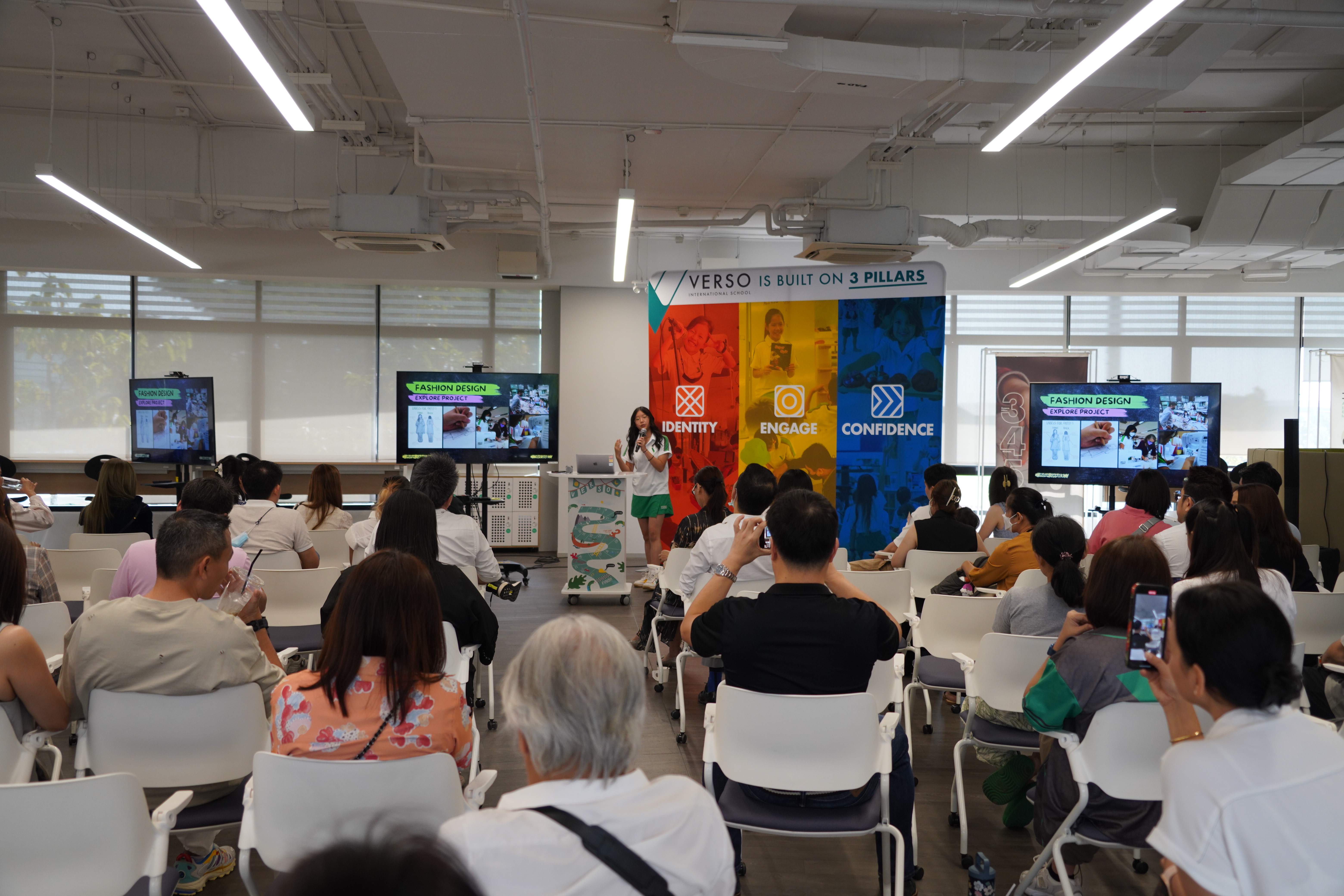From Problems to Solutions: My Design Thinking Journey at VERSO
Dive into the realm of design thinking through the eyes of our G8 student, Mona. She recently spoke to a group of parents, explaining how this creative problem-solving approach is integrated into our curriculum, empowering young minds like herself to ideate, innovate, and tackle real-world challenges, while equipping her with future-ready skills.
Design thinking is a way or method to solve problems while also generating innovative ideas. Just like any other skill, design thinking takes practice in order to improve a sense of identifying problems and thinking of creative solutions. At VERSO, students are encouraged to apply design thinking into the classes and projects we do. With the help from our Learning Designers (that's how we call our teachers here!), we are able to practice the skill of design thinking by facing problems we might encounter in the real world and use it to find solutions.
From a young age, being able to experience and practice this new way of thinking has impacted me hugely. By practicing and using design thinking a lot, it has helped me solve problems I have encountered and also helped me have more logic when trying to achieve my goals. When we do our personalized projects which are student-led, there are lots of obstacles that we will come across. When doing Explore projects, we need to identify the problem, the user, and then come up with a solution, all while using design thinking to support our rigor and process.
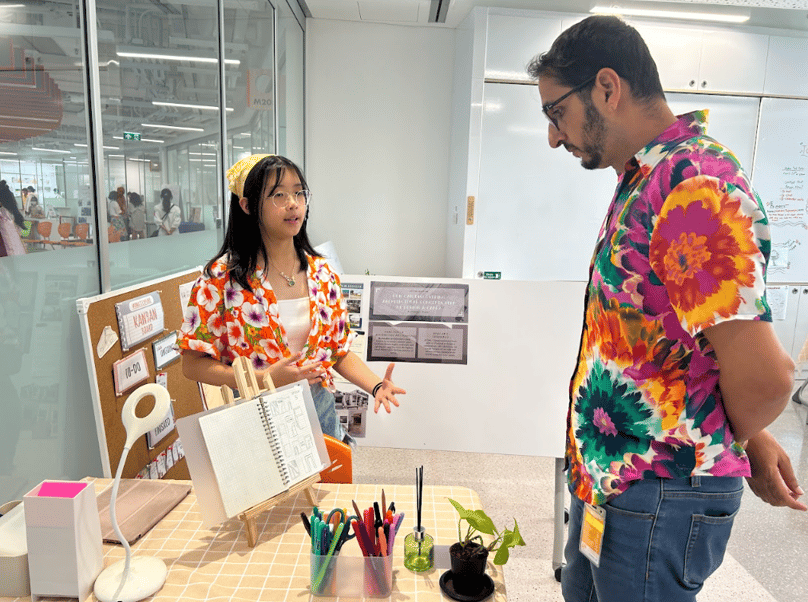 Mona presents a project addressing her Driving Question: How can discovering architectural concepts help me design a cafe?
Mona presents a project addressing her Driving Question: How can discovering architectural concepts help me design a cafe?
"By practicing and using design thinking a lot, it has helped me solve problems I have encountered and also helped me have more logic when trying to achieve my goals."
-MONA
When we start ideating and creating a plan for a project, we need to start off by identifying a problem. We can identify and decide on problems through relating to the real world or current problems going on, that’s why we have our uncovering stage. We also use tools like Ikigai charts or SWAT charts to help us further identify the problem. After that problem is discovered and we have a driving question, we start thinking of solutions that will help solve the problem. Once we have a goal and know where we are going, we start our process. With problems we face mid-way, we are able to use the knowledge we learned about design thinking and apply it to help us figure out what to do next. At VERSO, students from young ages all the way to older students are exposed to new processes of using design thinking to help us become future-ready problem solvers. This cycle then repeats, giving us the opportunity to practice and improve our skills in design thinking, preparing us for obstacles we might face in the future.
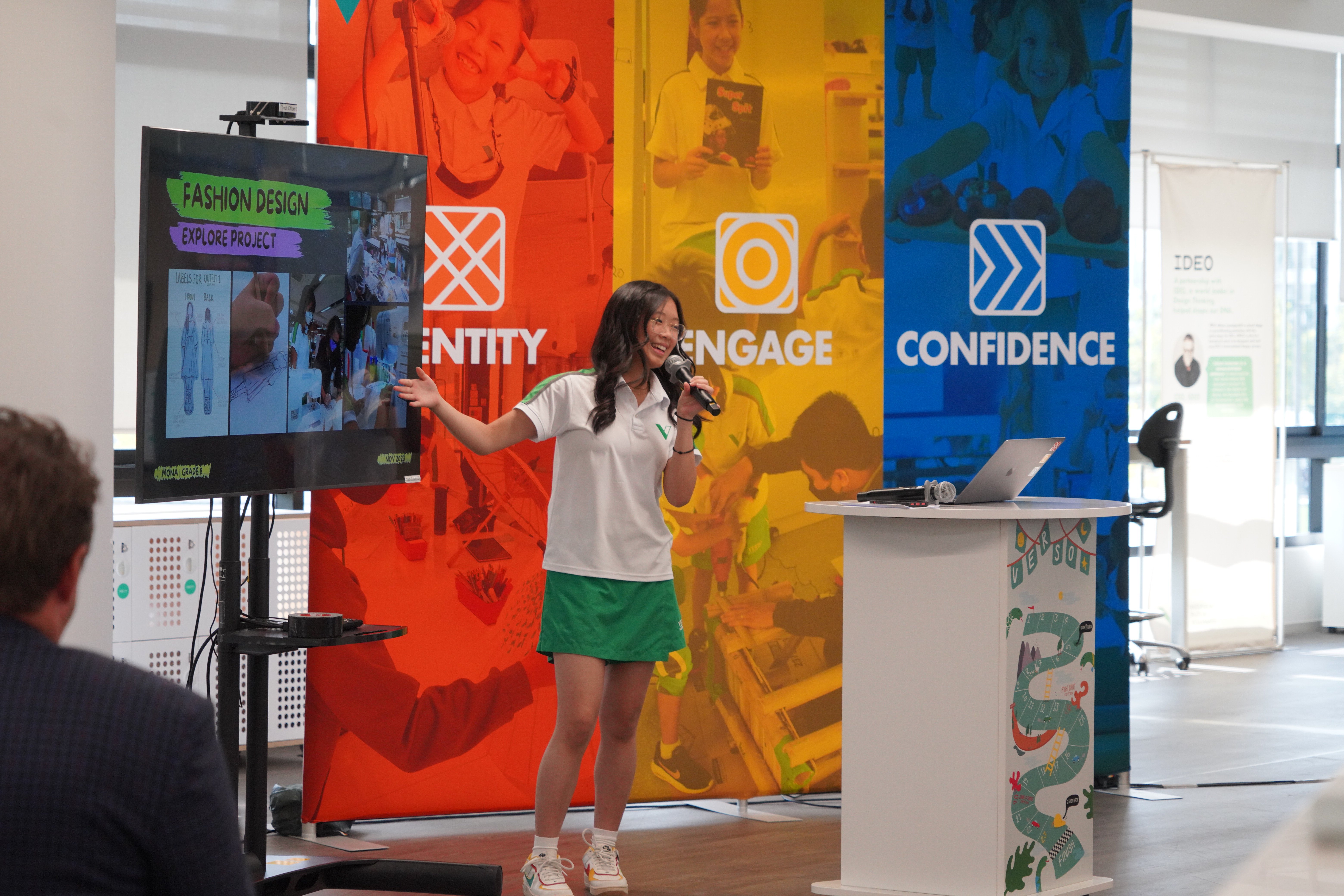
For example, when I was doing my Explore project on fashion design, I was faced with a problem - I knew I had a passion for design but I didn’t know what type. I didn’t know where to go next and how to prepare myself for further knowledge. I had decided on doing this Explore project to experience another type of design, graphic design being my first, so I could narrow down the direction I was going into.
After uncovering this problem, the next stage we would go to is ideating. Just creating a design piece wouldn’t be enough for me to determine what I wanted. With the help from my LD (Learning Designer) I was able to get in touch with a college student who was studying fashion design in Milan and she became my project mentor. Getting the opportunity to talk to her was very helpful. I saw a perspective of what it was like to study fashion design and learned about how I would need to prepare to follow this path, as well as picking up on handy skills. Along with that, I was able to connect with a professor from Chulalongkorn University and meet up with him. I had the opportunity to see some of the students’ works and talk to the professor about the programs and how I should prepare if I wanted to get into this field. To be able to get to this stage, I used design thinking along the way to plan out what to do.
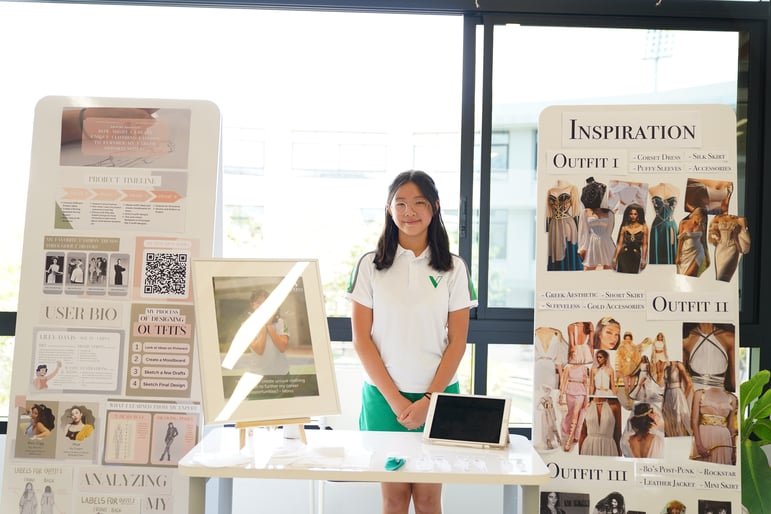
Mona and her Explore project on fashion design (above and below) where she used the principles of design thinking that not only showcased her creativity but also demonstrated the practical application of innovative design concepts
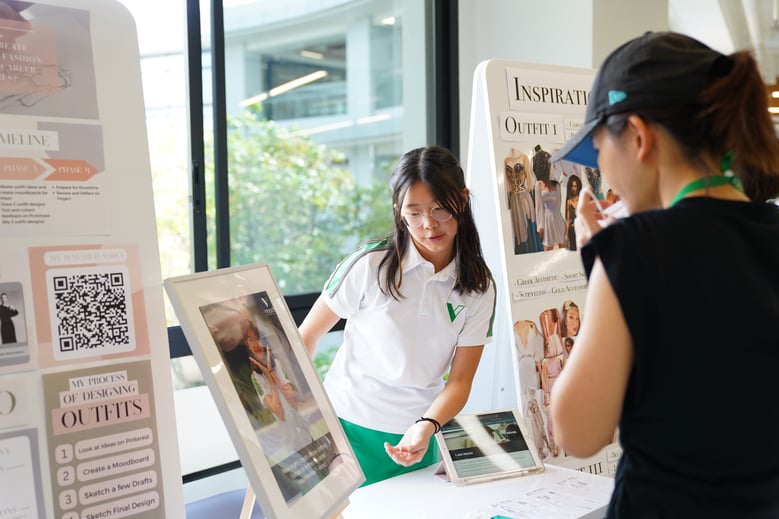
By practicing design thinking often, it starts to become easier to understand and apply it to situations. Especially starting at a young age, it gives us more time to explore and experience things the majority of kids our age don’t get to as yet. It teaches us how to deal with the real world and the reality we live in while staying innovative. For example, if I grow up and work in any type of workspace, most likely, I will face problems that I must overcome. When you come across a problem, using design thinking will help you create a process in order to find ideas to overcome this problem. If you go through this process multiple times, it makes it easier each time meaning it tends to become much more efficient. With anything I do in the future, design thinking can always be applied. If I end up becoming an entrepreneur, creating a business will be similar to doing the projects we do at VERSO. You identify a problem, you ideate for ideas, create prototypes and receive feedback to improve the quality of your end product. Design thinking will always be implemented into that cycle, and it can be implemented into almost anything.
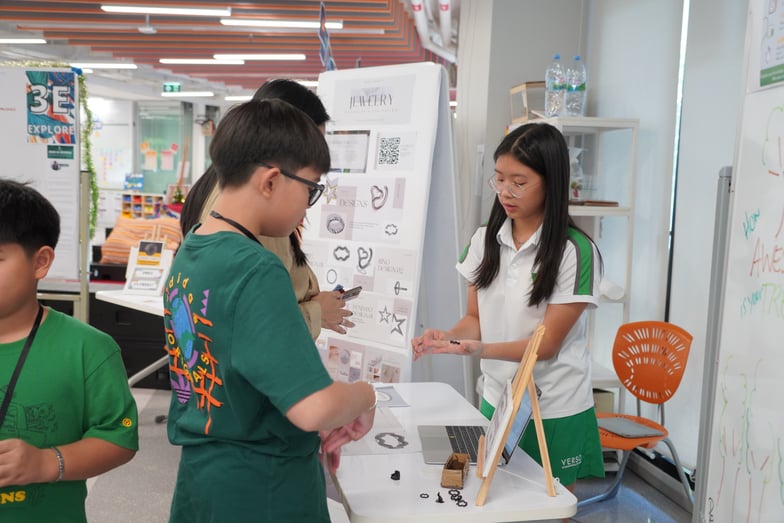 At the recent Middle Loop Walk and Talk ShowTime, Mona explain to parents (above and below) about her Explore project on jewelry design
At the recent Middle Loop Walk and Talk ShowTime, Mona explain to parents (above and below) about her Explore project on jewelry design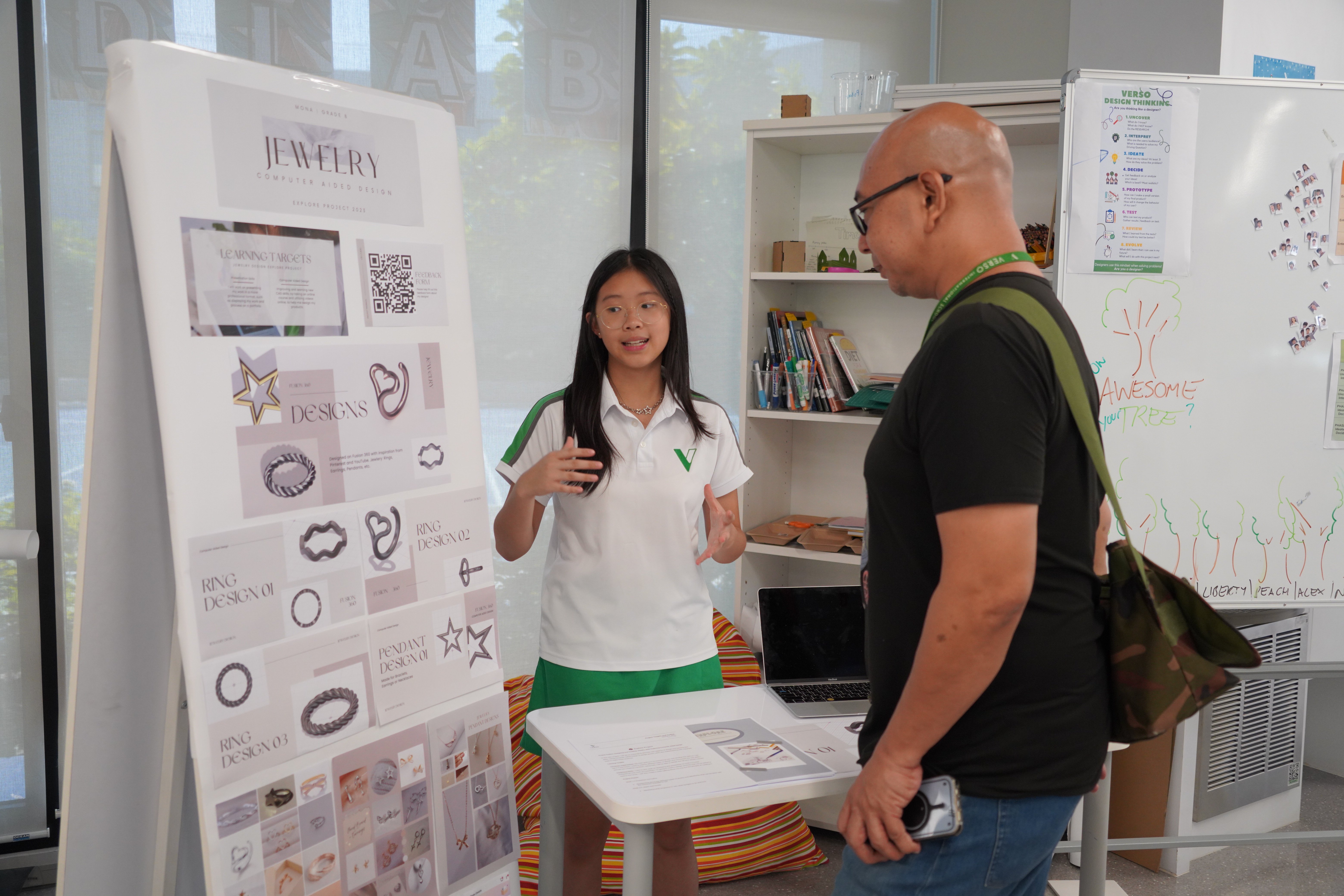
"When introduced at a young age, Design Thinking gives us more time to explore and experience things the majority of kids our age don’t get to as yet. It teaches us how to deal with the real world and the reality we live in while staying innovative."
-MONA
Design thinking also asks us to uncover and interpret what is already out there. For example, you may research simple bedroom cleaning techniques and come across information or tips you may or may not ever know existed. Design thinking isn’t just about coming up with your own way and being the first to make it happen, it’s also discovering what is already working in the world and what ideas are already out there. If you want to clean your room, your problem would be that your room is really messy. The solution is cleaning it up. But, no one wants to spend a long time cleaning it, so, you would usually create an easy plan in your head, like where to start off first and where to go next. Will you start off with cleaning your drawers or will you start off by clearing the table? If the first time you cleaned your room and you started off by cleaning your drawers first, and it took longer than you expected, then you may want to start off this time by clearing your table first.
"What VERSO does is prepare kids for the near future. Everything is constantly changing, and we must change with it. By practicing and being exposed to these life skills, we are one step ahead."
-MONA
As the cycle continues, you learn which way is most efficient and you stick with it. This may seem easy at first but once you are faced with much bigger problems than cleaning your room, you may need to go into more depth while using design thinking. Yes, everyone can clean their room but can everyone fix a bigger problem? A problem that may affect a larger number of people. If you are working, the way you handle the problem will have an effect on how well your business is and the end product. If you are stuck on that problem for a long time and don’t know what to do, it will slow down many other things.
What VERSO does is prepare kids for the near future. Everything is constantly changing, and we must change with it. By practicing and being exposed to these life skills, we are one step ahead.
Click here to watch Mona's presentation on Design Thinking.
